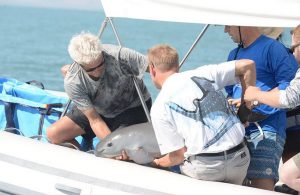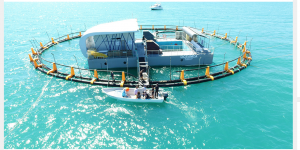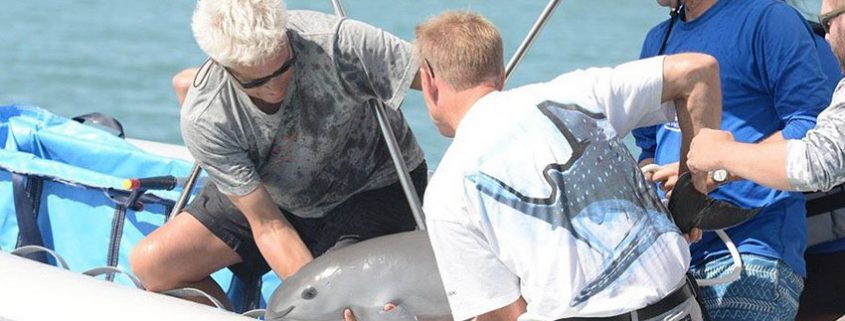A Story of Dramatic Conservation Effort: Saving the Vaquita Porpoise (Phocoena sinus) from Extinction
By Chelsea Black, SRC intern
It has been clear for several years that the vaquita porpoise (Phocoena sinus) is in danger of extinction, but only recently has the plight of this species received global attention. The vaquita is the most critically endangered marine mammal in the world and is endemic to the northern Gulf of California, Mexico (Rojas-Bracho, Reeves & Jaramillo-Legorreta, 2006). Genetic analyses and population simulations suggest that this species has always maintained a small population size (Rojas-Bracho et al., 2006), but accidental deaths caused by gillnet fishing gear have been the primary reason for their rapid demise (Jaramillo-Legorreta et al., 2007). Between the years of 1997 and 2015, the species experienced a population decline of 92% (Taylor et al., 2017). Population assessments estimated the population size of the vaquita to be at an alarming number of 60 in 2015, which then dropped to a total of 30 individuals by 2017. Over the past three years there have been dramatic efforts to save the vaquita from what seems like their inevitable extinction, which could be as early as 2018 according to the World Wildlife Fund.
Local fishermen in Mexico’s Gulf of California target the critically endangered fish, totoaba (Totoaba macdonaldi), for its swim bladder. The swim bladder is considered a delicacy in parts of Asia, selling for as much as $10,000 per kilogram (Mosbergen, 2016). It is in these gillnets meant to capture totoaba that vaquita become bycatch and eventually drown. In 2016, the International Whaling Commission approved emergency measures to permanently ban gillnet fishing from the vaquita’s range, remove existing gillnets, and suppress the illegal trade of totoaba (Mosbergen, 2016). However, scientists fear the removal of gillnets is not sufficient enough to save the remaining vaquitas, considering their extremely low population numbers. In response, active measures have been taken in an attempt to help save the species.
In June 2017, Mexico announced plans to use trained dolphins to help corral the remaining porpoises into a protected breeding sanctuary (“Mexico to use Dolphins,” 2017). The dolphins, previously trained by the US Navy to search for missing SCUBA divers, are trained to locate and herd the vaquitas to a marine refuge where they would ideally repopulate in safety. Unfortunately, the use of trained dolphins was not successful. The government then put together a team of marine mammal experts to go into the field and capture as many vaquitas as possible. To help with the conservation of the vaquita, the Mexican government created the Consortium for Vaquita Conservation, Protection, and Recovery (VaquitaCPR) to implement an action plan to prevent the extinction of the species. This plan is arguably the most dramatic conservation effort to date, but scientists are skeptical of how successful the program will be.
The rescue plan of VaquitaCPR includes four phases. Phase one involves locating and rescuing individuals followed by an evaluation of their suitability for human care. Phase two involves housing the vaquita in a marine sanctuary where, during phase three, the vaquitas breed in captivity. Finally, phase four is the release of the individuals back into the wild, and the ultimate goal of the entire project (“Rescue Efforts”).
In October 2017, Mexico announced the successful capture of a six-month old vaquita calf that was quickly released back into the wild because it was still dependent on its mother. This was the first ever capture of a vaquita, and left scientists optimistic that the goal of the VaquitaCPR team was indeed feasible (“New Recovery Project,” 2017). With a successful capture under their belt, the team of marine mammal experts set out to capture another vaquita, with the hopes of transporting it into the reserved area.

Figure 1: The first capture of a vaquita (source: vaquitaCPR.org)
In early November 2017, the VaquitaCPR team caught a second vaquita, but unfortunately this was not a success story. The mature female was captured and transported to a floating sea pen where veterinarians determined the animal was under extreme stress, and despite life-saving efforts the vaquita died within a few hours (Gaworecki, 2017). With such few individuals left, the loss of a female of reproductive-age is one of catastrophic proportion. Currently, the VaquitaCPR project has ceased all active measures to capture vaquitas, without ever successfully reaching phase two of their initial rescue plan.

Figure 2: Floating sea pen for captured vaquitas (source: Kerry Coughlin/National Marine Mammal Foundation).
The unfortunate truth could be that the vaquita porpoise is too stress-intolerant to endure capture and transportation, and this would make rebuilding their population in captivity impossible. Conservation efforts to save the remaining vaquitas will shift to removing all gillnets from their habitat, and a stricter enforcement of the illegal fishing of totoaba. The number of boats setting these particular gillnets in the vaquita’s range is minimal, and with the new permanent ban set by the Mexico government, hopefully these mitigations are sufficient to relieve pressure on the species. The success or failure of saving the vaquita from the brink of extinction will be a precedent in marine mammal conservation.
References
Gaworecki, M. (2017, November 08). Endangered Mexican Vaquita Dies After Rescue Effort. Retrieved November 20, 2017, from https://www.ecowatch.com/vaquita-dies-after-rescue-effort-2507794284.html
Jaramillo-Legorreta, A., Rojas-Bracho, L., Brownell Jr, R. L., Read, A. J., Reeves, R. R., Ralls, K., & Taylor, B. L. (2007). Saving the vaquita: immediate action, not more data. Conservation Biology, 1653-1655.
Mexico to use dolphins to save endangered vaquita porpoise. (2017, July 1). Retrieved November 20, 2017, from https://phys.org/news/2017-07-mexico-dolphins-endangered-vaquita-porpoise.html
Mosbergen, D. (2016, December 28). ‘Risky’ Last-Ditch Attempt To Save The World’s Smallest Porpoise. Retrieved November 20, 2017, from https://www.huffingtonpost.com/entry/vaquita-mexico-capture-plan_us_58635c2be4b0de3a08f69948
New recovery project captures vaquita porpoise calf. (2017, October 20). Retrieved November 20, 2017, from http://mexiconewsdaily.com/news/new-recovery-project-captures-vaquita-calf/
Rescue Efforts. (n.d.). Retrieved November 20, 2017, from https://www.vaquitacpr.org/rescue-efforts/
Rojas-Bracho, L., Reeves, R. R., & Jaramillo-Legorreta, A. (2006). Conservation of the vaquita Phocoena sinus. Mammal Review, 36(3), 179-216.
Taylor, B. L., Rojas‐Bracho, L., Moore, J., Jaramillo‐Legorreta, A., Ver Hoef, J. M., Cardenas‐Hinojosa, G., … & Thomas, L. (2017). Extinction is imminent for Mexico’s endemic porpoise unless fishery bycatch is eliminated. Conservation Letters, 10(5), 588-595.




Leave a Reply
Want to join the discussion?Feel free to contribute!